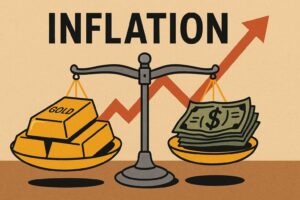Gold has been one of the best-performing assets in recent years, outpacing equities and even Bitcoin on a risk-adjusted basis. After hitting record highs in 2025, the big question on investors’ minds is simple: will the gold rally 2026 bring more gains, or is the bull market running out of steam?
According to most major analysts — the rally is far from over. Here’s why the uptrend may have much further to run, what risks to watch, and how you can position yourself to benefit.
Recap: The 2025 Rally That Set the Stage
In 2025, gold shattered records, trading well above $2,800 per ounce. Real yields fell, global tensions simmered, and inflation stayed sticky — creating a near-perfect environment for gold.
The numbers tell the story: according to the World Gold Council’s Q2 2025 Gold Demand Trends, total gold demand hit 1,249 tonnes — the highest on record. Central banks led the charge, purchasing more than 1,100 tonnes in 2024 alone (the second-highest total ever), with that momentum carrying into 2025. Private investors added fuel to the fire, and the rally took off.
For more context on what’s been driving prices higher, see 5 Key Drivers Behind the Gold & Silver Price Rally.
Key Drivers Powering Gold’s Strength in 2026
So what’s keeping this rally alive? Four major forces are converging to support higher prices.
Central Banks Are Still Buying Aggressively
The central bank buying spree isn’t slowing down. With over 1,100 tonnes purchased in 2024 and the trend accelerating through 2025, there’s every reason to believe this will continue into 2026 as nations diversify away from the U.S. dollar.
Goldman Sachs has highlighted the structural shift underway: central banks are increasingly diversifying reserves and reducing reliance on the U.S. dollar, signalling the de-dollarization trend is moving from concept into action.
Lower Real Yields and Monetary Easing
With the Federal Reserve expected to cut rates again by mid-2026, real yields are heading lower — and that’s historically been rocket fuel for gold prices.
When the Federal Reserve lowers interest rates, the “opportunity cost” of holding non-yielding assets like gold and silver declines. Investors earn less from bonds and savings, so capital often rotates toward stores of value that preserve purchasing power.
A Weakening Dollar and Mounting Fiscal Stress
The U.S. government’s fiscal deficits — projected to run above 6% of GDP through 2026 — are eroding confidence in the dollar. When global investors lose faith in paper currencies, they turn to neutral stores of value like gold.
Want to understand the basics of buying physical gold? Check out our Complete Guide to Buying Gold & Silver.
Persistent Inflation and Political Uncertainty
Even as headline CPI cools, core inflation and government debt pressures remain stubbornly high. Political risk isn’t going anywhere either — from trade tensions to elections, uncertainty tends to keep gold demand strong.
Bloomberg Intelligence highlights that elevated fiscal deficits, persistent inflation and geopolitical shocks are creating a structural environment favourable for gold as a safe-haven.
What Analysts Are Forecasting for 2026
Wall Street’s outlook for the gold rally 2026 is overwhelmingly bullish. According to Reuters, analysts are forecasting an annual average price above $4,000 per ounce for the first time.
Here’s what the major houses are projecting:
- Goldman Sachs’ gold price target is $4,440 in the first quarter of 2026, rising to $5,055 in the fourth quarter of next year.
- JP Morgan sees gold prices averaging $5,055 per ounce by late 2026
- Morgan Stanley forecasts gold prices to reach $4,500 by mid 2026
- And Bank of America raised their gold forecast to $5,000 by 2026
The common thread? All major houses expect gold to outperform most asset classes for another year or more.
Investor Takeaways and Strategy
Physical Ownership Still Wins
At GoldSilver, we emphasize the importance of owning physical gold — bars and coins you can hold in your hand. Physical bullion removes counterparty risk and gives you real control when financial uncertainty strikes. That’s a critical advantage over “paper gold” like ETFs.
Allocation and Timing
The smartest approach? Gradual, recurring purchases using a dollar-cost averaging strategy. This helps smooth out volatility. Many seasoned investors allocate 5–10% of their portfolio to gold as long-term insurance — not speculation.
Want to learn more about getting started? Visit our Learn to Invest in Gold & Silver section for step-by-step guidance.
Stay Informed
Macro conditions change fast. Tracking reliable data helps you anticipate the next move:
The Verdict: Gold’s 2026 Outlook Remains Strong
The gold rally looks poised to extend well into 2026, powered by central-bank accumulation, monetary easing, and long-term fiscal weakness in major economies. The forces driving this cycle are structural, not speculative.
For investors, the strategy is straightforward: hold a prudent allocation of physical gold, diversify your holdings, and maintain patience through short-term volatility.
Ready to explore your options? Check out our Complete Guide to Buying Gold & Silver or dive into our educational resources to build your investment knowledge.
Key Takeaways
- Gold demand hit record highs in 2025, setting up continued momentum.
- Central banks, deficits, and monetary easing point to a bullish 2026.
- Several analysts project $4,000 – $5,000/oz over the next year.
- Physical gold remains the most resilient and secure store of value.
- Monitor real yields, Fed policy, and the dollar for clues to the next phase.
People Also Ask
Will the gold rally continue in 2026?
Most analysts believe it will. Forecasts from Goldman Sachs, J.P. Morgan, and Morgan Stanley project gold between $3,000 – $4,000 per ounce by late 2026. Central bank buying, weaker real yields, and ongoing fiscal deficits all point to continued strength. See GoldSilver’s Learn to Invest page for how to position for the next phase of the gold rally.
What is driving the gold rally heading into 2026?
Key drivers include sustained central-bank accumulation, rate-cut expectations, dollar weakness, and persistent inflation. Together, these forces reduce opportunity costs and boost safe-haven demand — keeping gold’s uptrend intact. Read more in Why Gold Keeps Climbing.
How high could gold go by 2026?
- Goldman Sachs’ gold price target is $4,440 in the first quarter of 2026, rising to $5,055 in the fourth quarter of next year.
- JP Morgan sees gold prices averaging $5,055 per ounce by late 2026
- Morgan Stanley forecasts gold prices to reach $4,500 by mid 2026
- And Bank of America raised their gold forecast to $5,000 by 2026
See GoldSilver’s Complete Guide to Buying Gold & Silver for strategy tips.
What could stop the gold rally in 2026?
Potential headwinds include a hawkish Fed stance, a surging U.S. dollar, or a stronger-than-expected global recovery reducing safe-haven flows. However, these risks are seen as temporary within an ongoing structural bull market. For context, read Why Physical Gold Beats ETFs and Digital Gold.
With gold hitting new highs, is now a good time to invest?
Yes — many experts recommend gradual accumulation while prices consolidate. Owning physical gold offers portfolio protection ahead of potential new highs in 2026. Explore GoldSilver’s Learn to Invest hub for steps to buy, store, and diversify effectively.
Get Gold & Silver Insights Direct to Your Inbox
Join thousands of smart investors who receive expert analysis, market updates, and exclusive deals every week.









